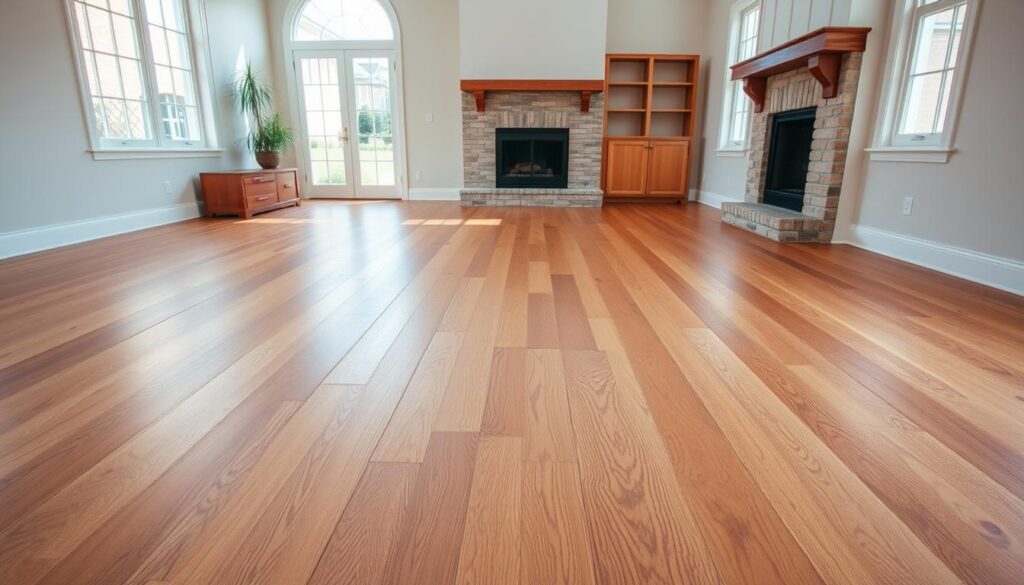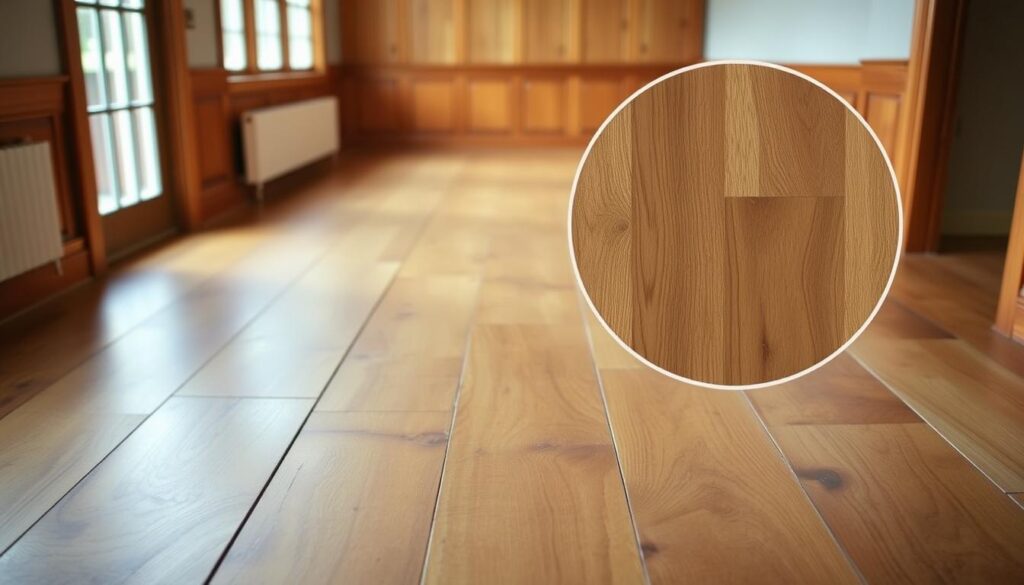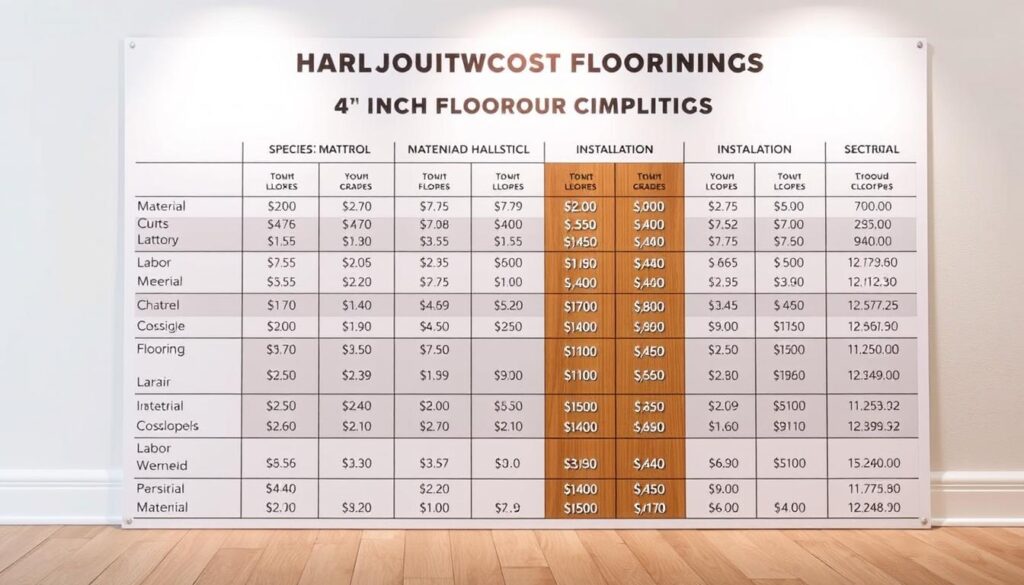Interested in 4 inch hardwood flooring? Our detailed listicle covers the pros, cons, and everything in between to guide your purchase decision.
Choosing the right flooring can change your home’s look and feel. 4 inch hardwood flooring is a great choice. It combines traditional charm with modern style, fitting almost any home.

The 4 inch width is very versatile. It’s not too narrow like old strips, nor too wide like today’s trends. These boards look good in any size space. You can find many wood types, finishes, and ways to install them to fit your needs.
Homeowners like this width because it’s stable in different temperatures and humidity. The 4 inch planks don’t gap or cup as much as wider ones. With the right care, these floors can last for many years, keeping their beauty.
Key Takeaways
- 4 inch hardwood planks offer ideal balance between traditional and modern styles
- Medium width boards provide better dimensional stability than wider planks
- This size works well in both small and large spaces
- Available in numerous domestic and exotic wood species
- Generally easier to install than extra-wide planks
- Typically falls in the mid-range price point for hardwood flooring
- Provides excellent long-term value with proper maintenance
Understanding 4 Inch Hardwood Flooring
The 4-inch hardwood flooring category is a great middle ground in hardwood plank width options. These planks offer a mix of traditional charm and practical benefits. They are loved for both classic and modern home designs.
What Defines 4 Inch Width Planks
When we talk about 4-inch flooring, we’re talking about the visible width. The actual board might be a bit wider due to tongue-and-groove edges. Manufacturers keep the width consistent, usually within 1/16 inch.
History and Popularity of Medium-Width Hardwoods
The 4-inch plank has a long history in American homes. Old colonial buildings used wide planks from old-growth forests. As time went on, narrower boards became more common.
By the mid-20th century, traditional flooring was usually 2¼ to 3¼ inches wide. The 4-inch width found a balance between old charm and modern needs.
Common Wood Species Available in 4 Inch Widths
Nearly all hardwood species are available in 4-inch widths. Each species has its own unique look:
- Oak (red and white): The most popular choice for durability and versatility
- Maple: Known for its light color and smooth grain pattern
- Hickory: Offers exceptional hardness and dramatic grain variations
- Cherry: Provides rich, warm tones that deepen with age
- Walnut: Features chocolate-brown colors with straight grain
These planks show off grain patterns well and stay stable through the seasons. They’re perfect for most homes.
The Versatility of 4 Inch Hardwood in Home Design
The 4-inch hardwood flooring is perfect for any home design. It looks great in both old and new homes. The size of these planks is just right, fitting well in any room size.
https://youtube.com/watch?v=xO_3oI4mEMI
Using 4-inch planks in your home is a smart choice. They work well in patterns like herringbone and parquet. This size also looks good with both light and dark stains, making the wood grain stand out.
In different rooms, these planks show their flexibility. They make living areas look elegant and refined. Bedrooms feel cozy and unique, thanks to the planks. Dining rooms get a timeless look that goes well with any table.
Pros of Choosing 4 Inch Hardwood Flooring
The 4-inch hardwood flooring size is perfect for those who want both function and beauty. It’s not too wide or too narrow. This size is ideal for many homeowners who want to add natural wood floors to their homes.
Dimensional Stability Advantages
4-inch planks are known for their stability. They don’t expand or contract much with changes in humidity. This means fewer gaps and less warping over time.
Places with big weather changes really benefit from this. It helps keep the floors looking good for longer.
Classic Aesthetic Appeal
4-inch planks have a timeless beauty. They’ve been in homes for years, adding a classic touch. They fit well in both old and new homes, letting the wood’s natural beauty shine.
Balanced Installation Costs
4-inch planks are also good for your wallet. They cost less than wider planks but cover more area. Installing them is easier, needing fewer pieces for the same space.
They also need less work on the subfloor. This makes them a smart choice for those watching their budget.
Potential Drawbacks to Consider
4-inch hardwood planks have many benefits, but they also have some downsides. They might not fit the style of homeowners who want ultra-modern looks. Wider planks offer a more dramatic look, which is missing in traditional 4-inch boards.
Installing 4-inch planks requires more boards per square foot than wider ones. This means more seams, which can weaken the floor over time. It also makes the installation process more complicated and can increase the cost.

The demand for 4-inch exotic wood species has dropped as wider planks become more popular. Many manufacturers now focus on wider options, leaving fewer choices for unique looks in 4-inch widths.
Cost is another issue. While traditional hardwood can be pricey, 4-inch planks might not offer the best value. Engineered hardwood floors often provide better stability at similar or lower costs, especially in wider widths.
Maintenance for all hardwood types, including 4-inch planks, is essential. Regular care is needed to avoid scratches, dents, and moisture damage. Refinishing every 7-10 years, depending on wear and traffic, is also required.
How 4 Inch Hardwood Flooring Compares to Other Widths
Choosing the right hardwood plank width can change how your space looks and feels. The 4-inch option is a good middle choice. It has benefits compared to narrower and wider planks.
4 Inch vs. Narrow Planks (2-3 Inches)
Narrow hardwood strips make a detailed pattern with many seams. But, 4-inch planks look cleaner and still have classic charm. Narrow strips need more time to install because you need more boards for the same area.
2-3 inch planks are very stable, with less change in size with the seasons. But, 4-inch planks balance stability with a wider look.
4 Inch vs. Wide Planks (5+ Inches)
Wide plank hardwood flooring makes a bold statement with fewer seams and a modern look. But, these wider boards are pricier and more affected by the environment. 4-inch boards are more affordable and still look clean.
Wide planks show off the wood’s natural beauty and grain patterns. But, 4-inch boards have a more uniform look that fits many design styles.
Impact on Room Perception and Space
The width of hardwood planks affects how we see room size. Narrow strips make a space feel traditional but busier. The 4-inch width adds interest without making small rooms feel cramped.
Wide plank hardwood makes small spaces look bigger by reducing seams. But, the 4-inch option is versatile and works well in any room size.
Cost Factors of 4 Inch Hardwood Flooring
When looking at 4-inch hardwood flooring, it’s important to consider several costs. The mid-width planks are priced moderately. This is because they use less material and are easier to install than wider or narrower planks.
Average Price Ranges by Wood Type
The cost of hardwood flooring changes a lot depending on the type of wood. Domestic woods like oak and maple cost between $3 and $8 per square foot. Premium woods like walnut or cherry can cost $8 to $12 per square foot.
Exotic woods, such as Brazilian cherry or tigerwood, can cost $10 to $15 per square foot. Engineered hardwood in 4-inch widths costs $4 to $9 per square foot. It looks like solid wood but is more stable in wet places.

Installation Cost Considerations
Installing 4-inch hardwood flooring costs between $3 and $5 per square foot for basic work. If the subfloor needs a lot of work, it can add $1 to $2 per square foot. More complex designs, like herringbone, can increase costs by 25-40%.
Rooms with stairs or special features cost more to install. Professional installers usually finish a room in 1-2 days. The cost depends on where you live.
Long-Term Value and Return on Investment
Hardwood flooring is a smart investment. It can return 70-80% of its cost when you sell your home. 4-inch planks are popular and show off traditional craftsmanship without stability issues.
Hardwood floors can last over 25 years with proper care. This means you won’t need to replace them as often as carpet or vinyl. This makes 4-inch hardwood flooring a great long-term choice.
Best Rooms for 4 Inch Hardwood Installation
Living rooms are great for 4-inch hardwood planks. The width adds interest without making the room feel cramped. It also provides stability in areas with changing humidity.
These planks create a timeless look that fits both classic and modern decor. They are perfect for main living areas.
Bedrooms look amazing with 4-inch hardwood planks. The width brings a sense of calm and warmth. It’s perfect for walking barefoot.
Master bedrooms especially benefit from this style. It adds elegance without taking away from other design elements.
Dining rooms and hallways also do well with 4-inch hardwood. They handle furniture weight well and don’t gap too much. Hallways look longer with these planks installed along the corridor.
Kitchens need special care with hardwood, even 4-inch planks. Use sealants and watch out for water. The width is good for kitchens because it has fewer seams, keeping moisture out.
Home offices and dens are also great for 4-inch hardwood. It’s durable for moving chairs and adds a professional look. It helps you focus and be productive.
Installation Techniques and Considerations
Installing 4-inch hardwood flooring needs careful planning and preparation. This ensures the flooring lasts long and looks great. These planks are versatile for different hardwood installation methods, like nail-down, glue-down, and floating.
Subfloor Requirements
A good subfloor is key for solid hardwood installation. Concrete subfloors need to be below 3% moisture. Wood subfloors should be between 6-9% moisture. Make sure your subfloor is clean, flat, and strong.
Plywood subfloors should be at least 5/8″ thick for nail-down.
Acclimation Process
Flooring acclimation helps wood adjust to your home’s humidity and temperature. Place unopened boxes in the room for 3-5 days. This is especially important for 4-inch planks to prevent gaps.
Keep an eye on moisture content until it matches your environment, usually 6-9% for homes.
Professional vs. DIY Installation
4-inch hardwood is more stable than wider planks. Your choice between professional or DIY installation depends on your skills and tools. Professionals ensure the job is done right and offer warranty protection.
- DIY needs specialized tools: floor nailer, moisture meter, miter saw
- Professionals handle tricky spots and custom cuts
- DIY saves money but takes longer
- Professionals usually include installation warranty
| Installation Method | Best For | Skill Level | Cost Range |
|---|---|---|---|
| Nail-down | Wood subfloors | Intermediate | $2-$3/sq ft |
| Glue-down | Concrete subfloors | Advanced | $3-$4/sq ft |
| Floating | Engineered wood | Beginner | $1-$2/sq ft |
Maintenance and Care Tips
Keeping your 4-inch planks in top shape is easy. Start by dust mopping daily with a microfiber cloth. This stops small particles from scratching your floors. For weekly cleaning, use a damp mop with a cleaner made for hardwood.
Changes in humidity can affect your floors, but 4-inch planks are less prone. Keep your home’s humidity between 35-55% to avoid gapping or cupping. Use felt pads under furniture and lift heavy items to avoid dragging.
- Clean spills right away to avoid water damage
- Use floor mats at entrances to catch dirt and moisture
- Avoid vinegar, ammonia, or steam cleaners that damage finish
- Keep pet nails trimmed to minimize scratches
Minor scratches can be fixed with touch-up markers. For deeper damage, you might need a pro. Refinish your floors every 7-10 years in busy areas. Less-used rooms might go 20+ years without needing a refinish.
| Maintenance Task | Frequency | Tools/Products |
|---|---|---|
| Dust mopping | Daily/as needed | Microfiber mop |
| Damp cleaning | Weekly | Hardwood cleaner, barely damp mop |
| Deep cleaning | Quarterly | Professional hardwood cleaner |
| Screening/recoating | 3-5 years | Buffer, fresh polyurethane |
| Full refinishing | 7-20 years | Sander, stain, finish coats |
Top Brands and Manufacturers of 4 Inch Hardwood Flooring
The market has many options from well-known hardwood flooring brands. They offer 4-inch planks that blend tradition and modern design. These boards are popular in homes across America.
Premium Brand Options
Bruce Hardwood is known for their Dundee series, featuring 4-inch solid oak planks. Mohawk’s TecWood line has advanced scratch-resistant finishes. Armstrong’s American Scrape collection offers hand-scraped textures in 4-inch widths.
These premium options come with 25+ year warranties and special finishing technologies.
Budget-Friendly Alternatives
For those looking for quality wood flooring without high prices, Somerset’s Classic Collection and Shaw’s Bellingham series are good choices. They offer 4-inch hardwood options with solid construction. Engineered options from Home Legend also save money while keeping the wood look.
Customer Satisfaction Ratings
Installer feedback and consumer reviews show Mirage as the top choice for 4-inch planks. Bruce and Shaw are leaders in customer service. Mohawk and Armstrong are praised for their finish durability.
Most quality hardwood flooring brands now have virtual tools. These help customers see how their 4-inch planks will look in different rooms.
Conclusion
Exploring 4 inch hardwood flooring shows it’s a great choice for many. It balances style and function well. Unlike wider planks, it doesn’t overwhelm, and narrower ones might feel too old-fashioned.
4 inch planks are stable and look classic, fitting many design styles. They’re also easier on the wallet than wider planks. This makes them a smart choice for those who want value without breaking the bank.
Choosing 4 inch hardwood flooring depends on what you like and your home’s layout. If you want a look that’s both balanced and stylish, these planks are perfect. Visit flooring stores, see samples, and talk to experts to see if they’re right for you.
FAQ
What defines 4-inch width hardwood planks?
The 4-inch width refers to the plank’s face, not the tongue and groove. Planks are usually milled between 3.75 and 4.25 inches. This range accounts for slight size variations.
How does the history and popularity of 4-inch hardwood flooring compare to other plank sizes?
4-inch hardwood planks offer a balanced look. They blend the wide boards of early colonial times with the narrow strips of the mid-20th century. This size has remained popular, appealing to many home design styles.
What are some of the most common wood species available in 4-inch widths?
Oak, maple, hickory, and other domestic hardwoods are often found in 4-inch widths. Exotic woods might be less common in this size compared to wider or narrower planks.
How does 4-inch hardwood flooring compare to narrower (2-3 inch) and wider (5+ inch) plank sizes in terms of visual impact and installation?
4-inch planks have fewer seams than narrow strips but keep a classic look. Wider planks make a bold statement but can be unstable and costlier. Medium-width 4-inch boards balance well, fitting various designs and offering practical benefits.
What are some of the key advantages of choosing 4-inch hardwood flooring?
4-inch hardwood planks are stable, timeless, and often less expensive than wider planks. Their medium width suits both traditional and modern designs, making them versatile and cost-effective.
Are there any potential drawbacks to consider with 4-inch hardwood flooring?
While versatile, 4-inch hardwood might not have the same impact as wider planks in modern spaces. Installation can also be more complex due to the need for more pieces and seams.
How do the average costs of 4-inch hardwood flooring compare to other width options?
4-inch hardwood is a cost-effective choice between narrow strips and wide boards. Prices vary by species, construction, and location. However, medium-width hardwood usually offers good value.
What are the best rooms or areas of the home for installing 4-inch hardwood flooring?
4-inch hardwood floors are ideal for living rooms, dining rooms, bedrooms, and hallways. They create a classic look. Kitchens and basements might be more challenging due to moisture, but engineered options can help.
What are the key installation considerations for 4-inch hardwood flooring?
Ensure a proper subfloor and allow for acclimation. Consider DIY or professional installation. Medium-width boards require extra attention to maintain a uniform look during installation.
How should homeowners approach the maintenance and care of 4-inch hardwood floors?
Clean regularly, adjust for humidity, and fix damage quickly. Knowing when to refinish and the right techniques for medium-width planks will extend the floor’s life.
Read also : Explore the Top 1 2 Hardwood Flooring Picks
